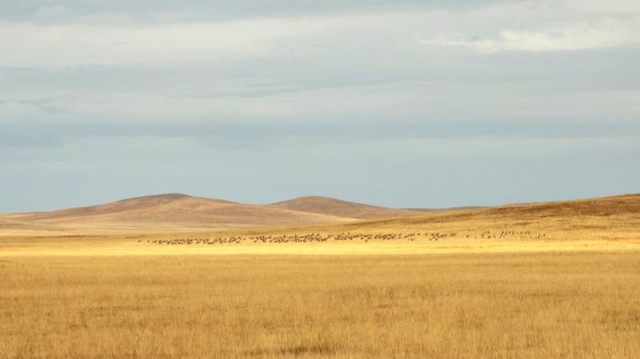steppe
MANY OF THE WORLD'S wide-open spaces, particularly in eastern Europe and central Asia, are considered to be steppe. A steppe is a plain mostly without trees, dominated by short grasses. This distinguishes a steppe from a PRAIRIE, which is usually qualified as having tall grasses. The word steppe is originally Russian, and it is in RUSSIA, UKRAINE, and KAZAKHSTAN where most steppes are found. Variations within areas considered to be steppe include regions that are drier, semidesert, or covered with low shrubs. The term steppe can also denote the climate of such regions—somewhat like the dryness of a desert and lacking the moisture to support the growth of trees. Steppe generally has a higher temperature and lower level of moisture than the TAIGA or forested belts further north, but not as extreme as areas of semidesert and desert. Elevations can determine this climate change as well: the slightly lower basins of otherwise forested SIBERIA can have steppe grasses, while conversely, raised areas amid the steppe become forested, like the Donets Ridge in eastern Ukraine, the mountains of the Crimea, and the LOESS foothills of the Central Asian mountains.

The Eurasian steppes start in the southern parts of MOLDOVA and Ukraine, cross most of southern Russia to the VOLGA RIVER and the southern URALs, and continue across southern Siberia and northern Kazakhstan until they encounter the high mountain ranges of MONGOLIA and northwestern CHINA. Extensions of this broad belt extend south in Russia toward the CAUCASUS, into western UZBEKISTAN, and into eastern Mongolia and northeast China. This west-to-east belt is generally about 125 mi (200 km) wide but narrows in the region immediately to the east of the Volga, where semidesert reaches further north, and at the point at which the band crosses the Urals.
Above this belt is another belt, of similar width, called the forest-steppe, which is a mixture of dry GRASSLANDS and wetter forested terrain. This foreststeppe belt extends in patches even further east, with isolated segments as far east as the Amur basin between Russia and China.
Drought is a constant feature in the steppe. Natural vegetation consists mainly of short grasses, but the steppe has been cultivated for other crops. Some areas also grow shrubs, and certain parts change from grasses to desert with the seasons. The soils of the steppes, while not as rich as the black earth (chernozems) of the forest-steppe zone, are very fertile and, with enough irrigation, can be brought to a high level of productivity, most suitably for wheat and sunflowers. Almost all of the Russian steppe has been brought under cultivation, though much of it suffers from overdevelopment, and the lack of trees makes the steppe susceptible to wind erosion.
Historically, the steppes of Central Asia and southern Russia have been home to nomadic peoples who adapted to their environment by creating a culture constantly on the move. The ancient Scythians were known for their prowess on horseback, and this theme can be traced through most of the other cultures who have lived in this area, including successive waves of Huns, Tatars, Cossacks, Kazakhs, and other Mongol or Turkic peoples.